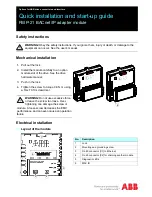
22
Fragment Threshold
The proposed protocol uses the frame fragmentation mechanism defined in
IEEE 802.11 to achieve parallel transmissions. A large data frame is
fragmented into several fragments each of size equal to fragment threshold.
By tuning the fragment threshold value, we can get varying fragment sizes.
The determination of an efficient fragment threshold is an important issue in
this scheme. If the fragment threshold is small, the overlap part of the
master and parallel transmissions is large. This means the spatial reuse
ratio of parallel transmissions is high. In contrast, with a large fragment
threshold, the overlap is small and the spatial reuse ratio is low. However
high fragment threshold leads to low fragment overhead. Hence there is a
trade-off between spatial re-use and fragment overhead.
Fragment threshold is the maximum packet size used for fragmentation.
Packets larger than the size programmed in this field will be fragmented If
you find that your corrupted packets or asymmetric packet reception (all
send packets, for example). You may want to try lowering your
fragmentation threshold. This will cause packets to be broken into smaller
fragments. These small fragments, if corrupted, can be resent faster than a
larger fragment. Fragmentation increases overhead, so you'll want to keep
this value as closeto the maximum value as possible.
RTS (Request To Send) Threshold
The RTS threshold is the packet size at which packet transmission is
governed by the RTS/CTS transaction. The IEEE 802.11-1997 standard
allows for short packets to be transmitted without RTS/CTS transactions.
Each station can have a different RTS threshold. RTS/CTS is used when the
data packet size exceeds the defined RTS threshold. With the CSMA/CA
transmission mechanism, the transmitting station sends out an RTS packet
to the receiving station, and waits for the receiving station to send back a
CTS (Clear to Send) packet before sending the actual packet data. This
setting is useful for networks with many clients. With many clients, and a
high network load, there will be many more collisions. By lowering the RTS
threshold, there may be fewer collisions, and performance should improve.
Basically, with a faster RTS threshold, the system can recover from
problems faster. RTS packets consume valuable bandwidth, however, so
setting this value too low will limit performance.
Beacon Interval
In addition to data frames that carry information from higher layers, 802.11
includes management and control frames that support data transfer. The
beacon frame, which is a type of management frame, provides the
"heartbea" of a wireless LAN, enabling stations to establish and maintain
communications in an orderly fashion. Beacon Interval represents the
amount of time between beacon transmissions. Before a station enters
power save mode, the station needs the beacon interval to know when to
wake up to receive the beacon (and learn whether there are buffered
frames at the access point).
Preamble Type
There are two preamble types defined in IEEE 802.11 specification. A long
preamble basically gives the decoder more time to process the preamble. All
802.11 devices support a long preamble. The short preamble is designed to
improve efficiency (for example, for VoIP systems). The difference between
the two is in the Synchronization field. The long preamble is 128 bits, and
theshort is 56 bits.


































